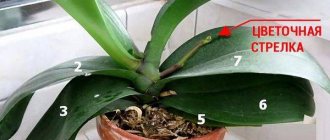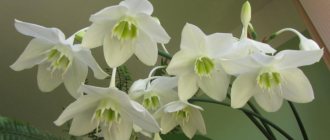If you follow all the rules of care, eucharis will delight you with its decorative foliage and abundance of fragrant inflorescences for many years. If gross mistakes are made, then problems will not take long to appear. Let's look at common errors and ways to eliminate them, and also try to answer frequently asked questions by flower growers.
general description
Eucharis is translated from ancient Greek as “beautiful, most lovely.” These indoor flowers (photo below) grow from a bulb. They belong to the amaryllis family. The genus of the presented plant includes more than 20 different species. They interbreed well with each other. Thanks to this ability, hybrid species of Eucharis are often found in the wild.
Read also: Why iPhone doesn’t see the SIM card
In addition, the presented flower can be crossed with the closest related species of the amaryllis family. In the wild, this plant is distributed in Central and South America.
Eucharis (Amazon lily) is most often found at the foot of the Andes on the Colombian side. This plant can also often be found in the Amazon basin. Thanks to this distribution in nature, this plant received the name Amazonian lily. Eucharis was introduced to Europe in the 19th century. Today this plant is actively grown throughout the continent.
Eucharis in winter
To replenish strength in winter, eucharis needs rest:
- All flower stalks are cut off.
- The temperature drops to 18 °C.
- Watering is carried out 3 and then 2 times a month.
- All types of fertilizing are stopped, spraying is not carried out.
- If the leaves turn yellow during the rest period, they should not be trimmed. Perhaps, after the activation of sap movement in the spring, their color will be restored.
Description
Eucharis is an evergreen plant. These indoor flowers (photo below) have oval leaves. They are quite wide, can reach 15 cm. The leaves are dark green in color.
Eucharis blooms with beautiful white flowers. They are quite large and emit a pleasant aroma. They grow on a long petiole. Its height can reach 45-65 cm. 3-6 buds are formed on the petiole. In some cases there may be more. If the conditions for flower growth are suitable, the buds bloom beautifully.
As a houseplant, Eucharis can live for several decades. Since this plant has been cultivated in our country for quite a long time, it has managed to adapt to existing conditions. With proper care, the Amazon lily can bloom two to three times a year. However, the presented plant is quite demanding in terms of growing conditions.
Types and varieties
The most common types of Eucharis in culture are:
Eucharis grandiflora
The bulbs of which have a diameter of 3-6 cm, broadly lanceolate leaves, on long petioles, white, fragrant flowers, up to 12 cm in diameter, collected in inflorescences of 3-6 pieces, peduncle length from 60 to 80 cm. Blooms in May, August and winter . Homeland - Colombian Andes.
In the photo: Eucharis grandiflora
White Eucharis (Eucharis candida)
Also from Colombia. It has an ovoid bulb up to 5 cm in diameter, broadly elliptical leaves up to 40 cm long and up to 15 cm wide, tapering towards the base and pointed at the apex. The peduncle is green with brown, in an umbrella-shaped inflorescence of 6-10 white fragrant flowers. Blooms in March.
In the photo: White Eucharis (Eucharis candida)
Eucharis mastersii
Also Colombian, with the same bulb as Eucharis alba, with broadly oval leaves up to 25 cm long and 15 cm wide, round at the base, on not very long petioles. On a round-shaped peduncle there are most often two umbels of flowers. It also blooms in March.
Rules for growing female happiness - spathiphyllum
Eucharis sanderi
Also native to South America, it has ovate-shaped bulbs, broadly oval leaves up to 30 cm long, up to 17 cm wide, heart-shaped at the base, on a petiole up to 15 cm long. On a rounded peduncle there is an umbrella with 2-3 white flowers, but there is a multi-flowered form with 4-6 small flowers in an inflorescence. The crown band is yellowish. Blooms in February-April. Usually grown on an industrial scale.
- How Achimenes blooms
In the photo: Amazonian Eucharis / Eucharis amazonica
Eucharis subedentata
Or Callifruria dentata also comes from the Colombian forests. The bulb is oval, the leaves are triangular, oblong, up to 23 cm in length and up to 11 cm in width, with long grooved petioles. On a narrow peduncle there are umbels with 6-8 white flowers.
Eucharis grandiflora is most often grown in culture.
Diseases and pests
The flowering of eucharis can be affected by some diseases and harmful insects that have settled on it. The most common diseases of eucharis are fungal infections. They are quite difficult to treat, but without treatment they lead to the death of the plant. A flower affected by fungi loses foliage, does not form flower stalks and gradually dies. The most common diseases of eucharis are:
- Root rot;
- Gray rot;
- Red burn.
Root rot is not visible in the early stages of development. Then the leaves of the plant turn yellow and dry out. When inspecting the root system, you can see a lot of rotten, blackened roots. The photo on the right shows healthy plant roots.
Read also: Why does a child drink a lot of water?
Gray rot affects the leaves of the plant. Small areas covered with gray mold appear on them. Diseased areas grow and cover all leaf blades.
Red burn affects the bulbs, leaves and flower stalks of the plant. Reddish areas are visible on the bulbs. The leaves are covered with red elongated spots. Peduncles are deformed, buds do not open.
To combat fungal diseases, it is necessary to use antifungal drugs. They treat the above-ground part of the plant, and in case of root rot, water it at the root. It is recommended to soak the bulbs in antifungal solutions before planting.
Eucharis suffers from the following pests:
- Spider mite;
- Thrips;
- Shchitovka;
- Amaryllis mealybug.
All these pests, multiplying in large numbers, can weaken the plant so much that it not only fails to bloom, but may even die. If harmful insects are detected, it is necessary to treat the bush with an insecticide solution (Aktellik, Fitoverm). The treatment is repeated until the pests are completely destroyed. It is better to use acaricides against spider mites - means to combat harmful arachnids.
When do the buds appear?
The Amazon lily blooms for the first time of the year in spring. The second flowering may occur in August or early September. However, experienced gardeners often achieve flowering in any other period.
You can tell that eucharis is ready to bloom by the presence of babies. If they appear, then you can expect flowers to appear soon. The main thing is not to plant young shoots in a separate pot.
- Eucharis is most often propagated by division. With this method of propagation, the young flower will be able to bloom in the second year of life.
- Eucharis can also be propagated by seeds. This process is longer and it will only take 5 years to wait for flowering.
The question of when euhariris blooms is discussed in more detail on this page.
Is it possible and necessary to stimulate the plant?
The flowering process is important for plants as it is the completion of the growing season. Plants bloom in order to be pollinated and reproduce. New young plants will appear from the formed seeds next year.
A plant may not bloom if it does not feel the need to reproduce. In this case, flowering can be stimulated by creating conditions of slight stress.
We are talking about forced transfer of eucharis into a period of rest , by:
- reducing watering;
- moving to a less lit place;
- lowering the room temperature.
In this way, experienced gardeners can make the plant bloom even at unusual times. And it’s easier to do this indoors, since it’s easier to control watering, lighting and temperature.
On the other hand, it is not always worth stimulating flowering; there is a risk that a weakened plant may stop blooming altogether . Therefore, experts recommend simply following the rules for keeping eucharis at home, then it will bloom on its own 1-2 times a year.
How to make an Amazon lily shoot out an arrow: step-by-step instructions
If the Amazon lily is not happy with its flowering, you can help it a little. To do this, you need to create special conditions and force the plant to retire :
- Move the plant to a darker place.
- Reduce the temperature to 15 C.
- Reduce watering the plant. Water only when the earthen ball dries out to two-thirds of the container.
- Be sure to stop any feeding.
After a month or two, the plant can be returned to its usual conditions. Usually, after taking these measures, eucharis blooms .
Eucharis is unpretentious in care and even a novice gardener can cope with its maintenance. By adhering to all the rules for caring for the plant, you can achieve effective flowering of eucharis every year.
A small number of bulbs
Eucharis is a “family” plant , therefore, when planting/transplanting it, a prerequisite is a sufficient number of daughter bulbs in the pot.) As a rule, 5 bulbs are considered sufficient . If your Eucharis has less than 3 of them, then most likely you will not be able to force it to bloom until it has acquired enough children. In this case, there is only one solution to the problem - wait until the Amazon lily grows children.
The air is too dry
Eucharis loves spraying and does not like dry air.
Even during the dormant period, the leaves must be sprayed or wiped with a damp cloth, since the air in apartments is dry, especially in the winter. With low humidity, Eucharis leaves may curl, bulb division may slow down, and flowering may not be expected.
The solution to the problem is simple - humidify the air or spray the leaves of the Amazon lily.
Important! If your plant is on a south or southeast windowsill, spraying should only be done in the early morning or late evening to avoid sunburn of the plant's leaves.
???? Location.
Initially, you need to find a suitable place for eucharis. Like many indoor plants, this flower is light-loving. However, the sun's rays, especially at midday, falling directly on the foliage can leave burns on it. Window sills of western and eastern windows are ideal.
In summer, eucharis can be placed on a balcony or terrace with good shading, away from direct sunlight. But at the first cold snap, it is better to bring the flower into the house to avoid illness or death.
What to do if eucharis does not bloom due to pests
Diseases and harmful insects greatly affect the Amazon lily's ability to bloom. A diseased plant may not only refuse to bloom, but over time the disease usually leads to its death.
Pests also happily settle on these flowers, causing a lack of budding, yellowing and falling of the foliage, and eventually the death of the eucharis. The most common diseases affecting the Amazon lily are the following fungal diseases: root rot, leaf rot and red burn.
The cause of root rot is excessive and prolonged soil moisture.
The fungus develops in a moist environment and penetrates the root system through mechanical damage or dead areas. In the early stages, root rot is not visible. Later, Eucharis begins to lose leaves. They turn yellow and wither en masse.
Plants can be treated only in the early stages of damage. In this case, replanting into new soil helps. The affected roots are removed. For preventive purposes and to destroy the fungus, the plant is watered at the root with antifungal drugs.
Leaf rot affects leaves when water gets into their axils. The fungus looks like a gray mold that covers areas of leaves and spreads quickly. When fighting leaf rot, all affected leaves are removed, and the plant is treated with antifungal drugs on top. For preventive purposes, you need to ensure that when spraying, less water gets on the leaves and dries out.
Red burn is a disease in which red spots of various configurations appear on the bulbs and leaves.
Peduncles grow ugly, and eucharis flowers do not bloom. No treatment has been developed. It is recommended to destroy diseased plants. When planting bulbs for preventive purposes, it is recommended to soak them in antifungal solutions.
Of the common pests of indoor plants that can live on eucharis:
- Red spider mite;
- Shchitovka;
- Thrips;
- Amaryllis mealybug.
If insects are detected, the plant must be immediately treated with insecticidal preparations.
What affects Eucharis grandiflora?
Parasites can live on eucharis.
The Amazon lily differs from other members of the family in its unpretentiousness. The plant easily forms buds every year. With proper care, you can get a profusely flowering crop.
To create a spectacular bush, you can plant several bulbs in a large container. Regular feeding stimulates the formation of numerous leaves. Eucharis is not recommended to be planted in a group with other plants. The indoor lily needs to create enough space.
Despite the significant benefits, complete non-compliance with the rules of care can cause plant damage and pests.
The main danger among insects for Eucharis are scale insects. The appearance of brown plaques on leaf blades and stems indicates damage to the flower.
Parasites can suck the juices out of the lily’s tissues in a matter of days of “inaction.” How to save eucharis? It is necessary to inspect the plant regularly. At the first signs of loss of leaf shine, drying and fallen areas are identified, pests should be collected. You can also remove insects using special traps.
The cleaned plant must be treated with a soap solution. It is advisable to wipe the leaves with a damp sponge dipped in soapy water. All areas should be sprayed with Actellica solution. You will need 0.15% drug. For one procedure, it is recommended to use two milliliters of the product and one liter of settled water.
Dry air combined with high environmental temperatures contributes to the settlement of thrips on lilies. Insect colonies primarily settle on the lower parts of the leaves. On the top of the plate you can see characteristic light marks.
Insecticides will be needed to kill pests. Decis, Fitoverm, Intavir and Actellik have an effective effect on parasites.
Care
Eucharis is decorative all year round, but in order to see its beautiful flowers you still need to follow the rules of caring for it.
Watering and fertilizing
Care in accordance with the growth cycle schedule: during the active growing season, many new leaves appear, so at this time we water it often, 2-3 times a week, especially if it is kept dry and hot.
Scheme of the life cycles of Eucharis: Roman numeral - the number of the month, the number next to it shows the first or second half of the month. Green color - active vegetation, foliage growth, red color - flowering, yellow color - plant rest
During the growth period, we regularly feed the plant; you can use a special fertilizer for bulbous plants. Very often, during the period of rapid growth of eucharis, fertilizers with a high nitrogen content are used to increase the green mass, then switching to fertilizing with potassium-phosphorus fertilizers for the establishment of flower stalks and abundant flowering. During the dormant period, eucharis is not fed.
It is advisable to water with soft water: melted snow or rain. If this is not possible, then ordinary tap water should be left in an open container (bucket, jar) for at least 1 day.
Recent entries Lilac perennials that are beautiful, compact and do not crowd out other plants Why when buying seedlings you should not take the sellers’ word for it and how to determine the age of the plant using 3 signs Tomato seedlings have become purple or whitish: why the color has changed and how to save the plants
Flowering period
With proper care, eucharis can bloom 2-3 times a year. The peduncle is tall, up to 70 cm, ending in 4–6 buds, which open alternately. At this time, it is undesirable to spray eucharis, since the white petals on which the drops have fallen become covered with brown spots.
Young children bloom only at 3–4 years old, and if kept closely together, so they should be planted several bulbs in one pot.
Typically, adult bulbs in the same pot produce flower stalks at the same time
For regular flowering, eucharis necessarily needs a change in periods of dormancy and active growth.
Why eucharis does not bloom and how to fix it - table
| Reason for lack of flowering | How to fix |
| Babe | A young baby blooms only at 3-4 years old, you’ll have to wait |
| Too spacious | Eucharis blooms only when surrounded by its own kind. Wait until it grows with children or plant the same plants with it. |
| Temperature changes | Eucharis does not like day and night temperature changes, so do not take them out into the fresh air and protect them from drafts. |
| No resting stage | After the next flowering, you need to arrange a semi-dry maintenance for 1.5–2 months, so that the soil in the pot dries out by half. |
Stress as a stimulation of flowering
Most often, to stimulate flowering, eucharis is stressed - it is not watered for 3-4 weeks, by this time the leaves may even lose turgor (elasticity). But also if the plant is in a dark room or it’s winter outside, then you can illuminate it with phytolamps or move it to a light windowsill. Sometimes replanting the plant helps.
What to do with a faded arrow?
Like all amaryllis, the flower arrow contains many nutrients, so it should be removed only after it has dried out. Of course, it is not very beautiful to see a yellow peduncle, but cutting it off, especially from young bulbs, is undesirable.
Rest period
Eucharis really needs a period of rest. At this time, it does not shed leaves, it simply consumes less moisture. The dormant period usually occurs after flowering. There is no need to water, much less feed, the plant.
A feature of eucharis is also that the dormant period does not always occur in the winter months. Often flower growers who go on vacation for the summer leave eucharis without watering, and it blooms in the fall.
During the dormant period, eucharis does not shed its leaves and remains very decorative.
In winter, the temperature in the apartment is almost the same as in summer, about 25 degrees, so it can grow, produce new leaves and even bloom. It is not at all necessary to arrange cold keeping with limited watering. But if possible, on short winter days you can add additional lighting with Full spectrum phytolamps (on northern windows) or conventional fluorescent or LED lamps, increasing the length of the day to 12 hours.
Bush formation
Eucharis grows from a bulb, so no form will work. The only recommendation is to grow several bulbs together.
Maintenance errors - table
| Description of the problem | Causes | Remedies |
| New leaves turn yellow and die, often without unfurling | Possible problems with roots, bulb rot | Dig up the onion, rinse and inspect for the presence of rot, which can even be inside the onion, with healthy external scales. |
| Gradually yellowing and dying of leaves | Natural process | Often you can see 2-3 leaves on one bulb. When a new one appears, the old one necessarily dies off. |
| Massive yellowing and dying of leaves | Overflow, especially when watered with cold water and kept at +10 | Remove from the pot, wash, cut out rotten areas, treat them with green paint or sprinkle with charcoal. Dry for a day and plant in fresh substrate. Water very little. |
| Loss of leaf elasticity | Lack of moisture | Most often it appears during the dormant period, when watered. If turgor is not restored, then perhaps the flower was overcooled in a draft or during transportation. |
| Curling leaves | Draft | Place in a warm place |
| Dry leaf tips | Lack of moisture in the soil and air | Adjust watering and spraying; you can wipe the leaves with a damp sponge. |
| Frequent death of old leaves as new ones appear | Possible lack of light (in winter) or nutrition | Supplement or feed with nitrogen fertilizers |
| Doesn't bloom | See table above | |
| Doesn't give birth to children | A cramped pot or too young plant | Usually, children appear on an adult bulb after flowering or in a spacious pot. |
| Leaves dry out and become covered with light spots | Excess light, sunburn | Often, out of ignorance, eucharis is placed on a south window, where the leaves can get severely burned. |
| In winter, the leaves dry unevenly around the edges. | Contact with a cold window | If eucharis stands on the windowsill in winter, then those leaves that are pressed against the glass often dry out green - they are cold. Move it further away. |
Errors in care are quite easy to correct, but sometimes the plant begins to get sick or is attacked by pests.
What conditions are required for the natural process?
In order for the plant to feel comfortable and bloom independently, it is necessary to create conditions similar to those found naturally in their native environment.
Reference! Eucharis loves space and takes up a lot of space. It is best that no other plants are located near the pot. If the pot is on the windowsill, there is no need to place neighbors next to it.
Lighting
Under natural conditions, Eucharis is found in the lower layers of the rainforest, so it does not like direct sunlight . If you want to put a flower pot on the windowsill, it is better to let it be an east or west window.
From the scorching sun, burns appear on the leaves of eucharis. During hot periods, it is better to remove the flower pot from the window and place it in a well-lit place, but protected from sunlight.
Watering
Eucharis does not like a lot of water. It should be watered only when the earthen ball has dried out by 3 cm. Excessive moisture can cause the bulb to rot . During the dormant period, watering is reduced, allowing the soil to dry out by two-thirds of the pot. You can water eucharis in a tray or directly into a flower pot, but you must avoid getting water on the bulb itself.
Eucharis is still a tropical plant, so the air humidity should be quite high. Frequent spraying of the leaves will be helpful. At the same time, it is strictly forbidden to allow moisture to get on the flowers. A good alternative is to wipe the leaves with a damp sponge. You can also place a cup of water next to the plant.
Important! Tap water is not suitable for irrigation. It is best to collect it in advance and leave it for about a day in an open container. The water should be at room temperature.
Temperature
- In summer, the most comfortable temperature for eucharis will be 22 0C. It is important to avoid sudden changes in temperature during the day - this will lead to a decrease in the size of the flowers.
- In winter, during the dormant period, eucharis can be kept at a temperature of about 15 0C.
- For comfortable growth you need at least 18 0C.
Feeding
Eucharis should be fed only during the period of growth and flowering. It is recommended to apply fertilizer once every 2 weeks. During the dormant period, fertilizing should not be carried out .
Eucharis will not bloom if the soil is oversaturated with nitrogen. It is better to opt for organic fertilizers.
Transfer
Eucharis does not like frequent .
- An adult plant should be replanted no more often than once every 3 years in the spring.
- It is better to plant several bulbs in one pot. This way the root system will develop faster and the possibility of flowering will appear.
- After transplanting, you need to stop watering for a couple of weeks.
Transshipment is considered the best way to transplant eucharis . The flower should be replanted into a new pot together with a lump of earth.
A drainage layer is needed at the bottom of the pot. Traditional expanded clay is well suited for this. The soil for planting must be nutritious and moisture-absorbing.
You can use ready-made soil for flowering plants, or you can mix leaf soil, sand and humus.
We looked at the composition of the soil for eucharis in detail here.
Reasons for lack of flowering. What to do if only leaves grow?
Why does the Amazon lily not bloom at home, but only produce leaves? First of all, you need to pay attention to the watering regime of the flower. A possible reason is overwatering and overfeeding the plant . As a result, eucharis cannot independently enter the resting phase and actively grows foliage. And since it is during the dormant period that flower buds are formed in the bulb, there is no need to expect any flowering.
Attention! The reason for the build-up of excess green mass can be fertilizers containing nitrogen. An excess of this mineral element leads to increased leaf growth and lack of flowering.
Beginning flower growers sometimes associate the lack of buds with the fact that there are few leaves on the bulbs. But their number has nothing to do with flowering (except in extreme cases when there are none at all). Under standard conditions, each bulb has three to four leaves.
The Amazon lily likes to be relatively cramped in a pot. It follows that eucharis does not need a spacious container. It has been noticed that the plant does not bloom until it grows with children and completely takes over the space. Therefore, you need to plant even 3-5 bulbs in one pot, so the plants will spend less energy on the development of the root part and will bloom faster.
Also, lack of flowering can be a direct consequence of improper care. We talked in detail about caring for this plant here.
The problem is in the pot
For abundant flowering of eucharis, it must be planted in a tight pot. It should not be very small, but the root system of the plant should touch its walls.
Often this flower is planted in a large pot “not growing”, and then they cannot get a peduncle to appear. This is quite natural. After all, until the roots of the plant grow so much that they touch the walls of the pot, it will not bloom. And this will not happen soon in a spacious pot.
When transplanting eucharis, the size of the pot is chosen depending on the size of the root system. It is necessary that the roots do not reach the walls by more than 1 cm. This will provide space for the plant to develop. But the root system will quickly grow to the walls of the pot, and the plant will begin to bloom.
To quickly achieve lush flowering, experts recommend planting several eucharis bulbs at once in a tight pot. Then each bulb will release a peduncle, flowering will be abundant.
Sometimes the plant refuses to bloom even in a cramped pot. Here you need to pay attention to the age of the bulb. Each specimen of Eucharis can grow buds only when it reaches a certain age. Very young plants cannot flower. Only specimens in which babies have begun to form on the bulbs are capable of blooming.
You should also pay attention to the shape of the pot. It shouldn't be too high. In a tall pot, the natural drying of the soil is slowed down; its bottom layer can remain wet for a long time. And since most of the plant’s root system is concentrated at the bottom of the pot, stagnation of moisture will quickly lead to root disease.
The ideal shape of a pot for eucharis should be such that its height is equal to the diameter of the pot. It may be a little larger, but good drainage is necessary to remove excess water.
When and how to replant eucharis
Amazonian lily does not like transplants. Therefore, if the plant is healthy, blooms well and does not fall out of the flower pot, it can not be disturbed for three to four years.
A healthy flower is transplanted when many “children” have been formed and they interfere with the normal growth of the flower.
The daughter material can be used to propagate the plant, or it may not be separated from the mother flower. In the latter case—transplanting into renewed soil without separation—you can achieve more luxuriant flowering of the lily.
March is the most favorable month for replanting a plant. A healthy plant is transplanted into prepared soil using the transshipment method, without disturbing the earthen coma.
If the flower bulbs are rotten, they are carefully removed from the soil and washed with water. Then the rot is removed (cut). The cut surface is thoroughly disinfected by immersing it in a fungicide solution. Then sprinkle the cut with wood ash.
Depending on the initial planting material (bulb with and without leaves), there are two options for planting the plant.
Planting Amazon lily with leaves
How to plant eucharis photo
Leaves are not trimmed before planting, only those that are yellowed and dying are removed.
- Planting depth - 5-6 cm.
- The container for planting is tall, not wide, with a hole in the bottom and drainage at the bottom made of expanded clay or small pebbles.
- Watering is moderate for the first 3 weeks, as the soil dries.
- The location is bright and warm.
Planting an Amazon lily without leaves
Before planting, the leaves are completely cut off at a height of 1 cm above the bulb.
- Planting depth - the top of the bulb looks 0.5 cm above the soil surface.
- The container for planting is 2-3 cm larger in diameter than the diameter of the bulb.
- The soil is half sand.
- Watering is moderate for the first three weeks, as the soil dries.
- The location is bright and warm.
If you planted an Amazon lily bulb without leaves, the plant will grow new leaves approximately 40 days after planting. The fact that the top of the bulb is above the surface of the ground will make it easy to observe the growth and development of the plant.
Reproduction
The indoor lily reproduces with the help of small bulbs extending from the mother. Separating the children from the main bulb and planting them in separate pots is carried out in April - May.
To do this you need:
- Fill the pot with a layer of drainage and soil;
- Place a small onion there to a depth of no more than 5 cm;
- Sprinkle with a thin layer of earth;
- Water a little.
Experts recommend planting several “babies” in one pot, then flowering will be more abundant and longer. You need to plant the bulbs very carefully, without damaging them.
Propagating a flower from seeds is a rather troublesome and time-consuming task. In this case, the lily develops very slowly and begins to bloom for the first time only 5 years after planting. Seed material that has expired will not sprout, so you should be careful when purchasing it.
Bulb transplantation
The soil should be completely renewed once a year. This stimulates the growth of the lily and is a good prevention of diseases, pests and parasites. Small children are separated from the large bulb and each placed in their own pot.
Every gardener should know how to plant lilies. To transplant, the bulbs are carefully dug up and cleared of soil, and the children are removed with a sharp knife. If the tuber begins to rot, the affected areas are cut off. Next, the bulbs are disinfected in a solution of potassium permanganate and dried, so that they can be planted in the spring. You can dry it on the windowsill by laying a newspaper or a piece of thick fabric there. Store planting material in a dry and dark place, in cotton bags.
Transplantation is the most important care event.
Earth for eucharis
Eucharis flower care at home Houseplant eucharis photo
Eucharis loves fertile soil with good water and breathability.
The most convenient way is to purchase special soil in a store. You need to choose soil marked “For plants of the amaryllis family.” If this is not possible, you can prepare it yourself by mixing the following ingredients:
- humus 1 share;
- leaf soil 2 shares;
- river sand 1 share;
- peat 0.5 shares.
The plant must be provided with drainage from coconut shells, expanded clay, and small stones. It will remove excess moisture.
Frequency of Eucharis flowering at home
What is the frequency of the appearance of flowers in the Amazon lily (eucharis) is of interest not only to those who have recently acquired this magnificent color, but also to those who have already been familiar with this plant for a long time and try to look after it in anticipation of fragrant flowers, but never get what they want result.
Amazon lily eucharis - home care
Quite often, mistakes made in caring for the plant prevent you from waiting for the flowering period. If you do not know the main requirements, this will negatively affect the growth and development of the Amazon lily.
If alternate dying and yellowing of leaves on Eucharis occurs, this can be attributed to a natural process. When gardeners begin to wonder why the leaves of eucharis turn yellow at the same time, it means that the plant has serious problems. The reason for this may be:
- excessive or weak watering. This makes the leaves and roots weak. Proper watering gives the leaves elasticity;
- low temperature (below 10 °C) in the room. This will most likely cause the foliage to curl and wilt;
- the leaves get sunburned. As a result, yellowing of the foliage occurs.
But in these cases there is a chance to revive the flower. The gardener needs:
- Remove the flower from the pot and check for rot on the bulb.
- Cut off the affected areas and treat the cut areas with ash.
- Dry the tubers and transplant them into a new pot.
When do the first buds appear? Most often, eucharis begins to delight gardeners with its beauty in spring and autumn. The appearance of white flowers, reminiscent of daffodils, is accompanied by a delightful aroma. Sometimes flowering occurs around Christmas. At this time, other plants are dormant. However, Christmas days for budding are rare. Most often the main flowering time is February-March. The event is marked by the appearance of a long peduncle with a cluster of luxurious, blooming flowers.
Note! Favorable conditions allow the Amazon lily to form two or more flower stalks. Only experienced flower growers manage to achieve three flowering times: in spring in May, in summer in August and in winter.
The opening of the buds occurs alternately. Each flower lasts for 7-10 days. The entire inflorescence delights home gardeners with its beauty for 20 days.
Unfortunately, the flowering of Eucharis is not prolonged. When the flowers fade, the plant needs a period of rest to gain strength to produce new flowers.
The result of proper care
Transfer
How to replant indoor lilies? Replanting should be done every year with a complete replacement of the soil. During the flowering period of the lily, the soil manages to be depleted and loses most of its nutrients, so you may not be able to wait for the full development of the bulb and high-quality flowering.
The most important thing is the correct preparation of the bulbs for the dormant period and subsequent transplantation. After the above-ground parts die off, the bulbs are dug up and washed, clearing them of soil.
Small bulbs - the children are immediately selected and planted in seedling boxes. They will actively grow all winter, gaining strength.
Large bulbs are inspected, rot spots are cut out, treating the sections with crushed charcoal (charcoal or activated). If the stem has not yet fallen off, it needs to be cut off, leaving a stump 4-6 cm long. The bulbs are disinfected by immersing them in a solution of fungicides or potassium permanganate for 25-40 minutes. Then they are dried on paper or soft material and stored in the cold.
At the end of February - March, the bulbs are taken out of the bag and planted in a pot with soil.











